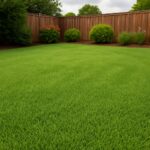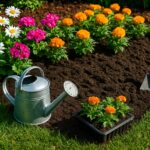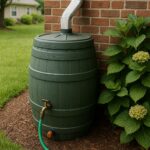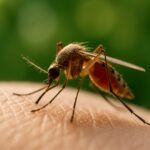Atlanta, GA Yard & Garden Guide
Welcome to your essential guide for yards and gardens in Atlanta, Georgia! Atlanta is famous for its tree canopy, rolling terrain, and mix of urban and suburban neighborhoods. With a humid subtropical climate (USDA Zone 7b/8a), local homeowners experience long, warm summers and mild winters—but also heavy clay soils, shifting rainfall, and rapid weed or pest growth.
Whether you’re planning your first raised bed, reviving a Southern lawn, or looking to boost curb appeal, this guide is your local roadmap. We’ll cover the best lawn care practices, gardening advice, irrigation know-how, smart DIY projects, seasonal checklists, and trusted Atlanta resources to help you create a thriving outdoor space all year long.
Lawn Care for Atlanta’s Climate
Atlanta lawns are known for their vibrant greens in spring and summer—but getting that healthy look takes smart planning. Atlanta’s soil is naturally heavy clay, which can lead to drainage and compaction issues. Summers are hot and humid, while winters are usually mild but can include the occasional cold snap.
- Grass Selection: Warm-season grasses like Bermuda, Zoysia, and Centipede thrive in Atlanta’s summer heat. Fescue is also popular for shade but needs extra care in summer.
- Soil Prep: Test your soil before planting. Most Atlanta lawns need annual aeration and topdressing with compost to fight compaction and improve drainage.
- Fertilizing: Feed warm-season grasses from late spring to early summer, following soil test results. Avoid heavy fertilization in fall, which can lead to disease.
- Mowing: Mow regularly but avoid scalping—keep blades high to shade roots and conserve moisture. Sharpen mower blades at least twice a season.
- Watering: Aim for 1–1.5 inches of water per week, preferably in the early morning. Deep, infrequent watering builds drought tolerance. Watering too late in the day invites disease.
- Weed & Pest Control: Stay ahead of crabgrass, dandelions, and common fungal diseases (like brown patch). Use pre-emergent in early spring and spot-treat as needed. Grubs and armyworms can strike in late summer—keep an eye out and treat quickly if you spot damage.
Pro Tip: Aerate your lawn every fall to relieve compaction and allow roots to breathe, especially if you have heavy foot traffic or pets.
Gardening in Atlanta: Flowers, Veggies & Native Plants
Atlanta’s long growing season, abundant rainfall, and warm weather make it a dream for gardeners—if you know how to handle the red clay! From Southern classics like hydrangeas and azaleas to drought-tolerant natives and productive vegetable beds, there’s plenty to grow in every Atlanta yard.
- Top Ornamentals: Hydrangea, azalea, camellia, gardenia, lantana, and crepe myrtle provide year-round color and Southern flair. Native perennials like black-eyed Susan and coneflower are tough and pollinator-friendly.
- Soil Improvement: Mix compost or pine bark into clay-heavy beds to boost drainage and root health. Raised beds are a smart choice for both vegetables and flowers.
- Shade Gardening: Atlanta’s mature trees mean plenty of shade. Hostas, ferns, and hellebores thrive in dappled light; azaleas and camellias do well beneath tall pines.
- Vegetable Gardens: Plant tomatoes, peppers, beans, and squash in late April to early May. Collards, kale, and lettuce love fall’s cooler weather.
- Mulching: Use 2–3 inches of shredded pine bark or straw to retain moisture, suppress weeds, and keep soil cool in summer.
- Pest Watch: Aphids, spider mites, Japanese beetles, and powdery mildew are common Atlanta garden problems. Treat early with organic or IPM methods.
Pro Tip: Atlanta’s last frost date is usually mid-April—don’t rush spring planting, and always check soil temps before sowing warm-season crops.
Irrigation & Watering Tips for Atlanta Yards
Atlanta’s rainfall is generous in spring and summer but can drop off quickly in late summer or during drought years. Heavy clay soils can also mean water runs off before it can soak in, leaving some areas too wet and others too dry. Here’s how to water smarter:
- Drip Irrigation: Great for garden beds and foundations—reduces runoff, targets roots, and conserves water.
- Soaker Hoses: Effective for flower and veggie beds; lay hoses under mulch to maximize absorption and minimize evaporation.
- Sprinkler Timing: Water lawns and gardens early in the morning (before 9am) for maximum efficiency and to prevent fungal disease.
- Rain Barrels: Harvest rainwater from downspouts to use during dry spells—check local rebates for installation.
- Check for Watering Restrictions: Atlanta occasionally enforces watering restrictions during drought. Always follow local guidelines and adjust timers as needed.
Pro Tip: If water puddles on the surface, pause and water in intervals so soil can absorb it. Consider core aeration to help water penetrate clay-heavy lawns.
DIY Projects for Curb Appeal & Productivity
Atlanta homeowners love adding personal flair to their yards—whether it’s boosting curb appeal, making space for pollinators, or growing more food. Here are some DIY ideas perfect for Atlanta’s climate:
- Build Raised Beds: Raised garden beds are ideal for overcoming heavy clay soil and growing veggies or flowers.
- Pollinator Habitats: Create butterfly gardens with native milkweed, coneflower, and black-eyed Susan to support local wildlife.
- Compost Bins: Start a backyard compost system using leaves, grass clippings, and kitchen scraps to build better soil.
- Rain Gardens: Install a rain garden in a low spot to manage runoff and filter stormwater naturally.
- Edible Landscaping: Add blueberry bushes, fig trees, or muscadine grapes for a harvest you can enjoy year after year.
Pro Tip: Choose Southern-adapted, disease-resistant plants for all your projects to reduce maintenance and boost success.
Seasonal Checklist for Atlanta Yards
- Spring: Aerate lawns, apply pre-emergent weed control, plant annuals, fertilize warm-season grasses, and mulch beds.
- Summer: Mow regularly, monitor for heat stress and pests, water deeply but less often, and deadhead flowers for continuous blooms.
- Fall: Overseed fescue lawns, plant bulbs, refresh mulch, divide perennials, and plant cool-season veggies.
- Winter: Prune trees and shrubs, clean up debris, plan next season’s garden, and protect sensitive plants during cold snaps.
Monthly tip: Check local extension resources for monthly task lists tailored to Atlanta’s microclimates and shifting weather.
Trusted Atlanta Yard & Garden Resources
- UGA Extension – Fulton County
- City of Atlanta Water – Yard Care Tips
- Georgia Botanical Society Resources
- Recommended local nurseries: Pike Nurseries, Garden*Hood Atlanta, Habersham Gardens
Frequently Asked Questions for Atlanta Yards
- What’s the best grass for Atlanta lawns?
Bermuda and Zoysia are top picks for sun, while fescue is best for shade—but all need soil prep and annual aeration for best results. - How can I improve my heavy clay soil?
Topdress lawns and beds with compost, aerate in fall, and mix pine bark or sand into new garden beds to boost drainage. - When should I fertilize my lawn?
Fertilize warm-season grasses in late spring to early summer, following soil test results. Fescue lawns are fertilized in fall. - Can I garden year-round in Atlanta?
Yes! Spring and fall are best for veggies; many ornamentals bloom year-round, and you can garden 10+ months each year with the right plants. - How do I deal with drought or water restrictions?
Install drip irrigation, mulch deeply, choose drought-tolerant plants, and always check the City of Atlanta Water’s latest guidelines.





